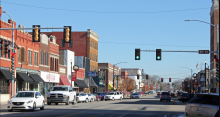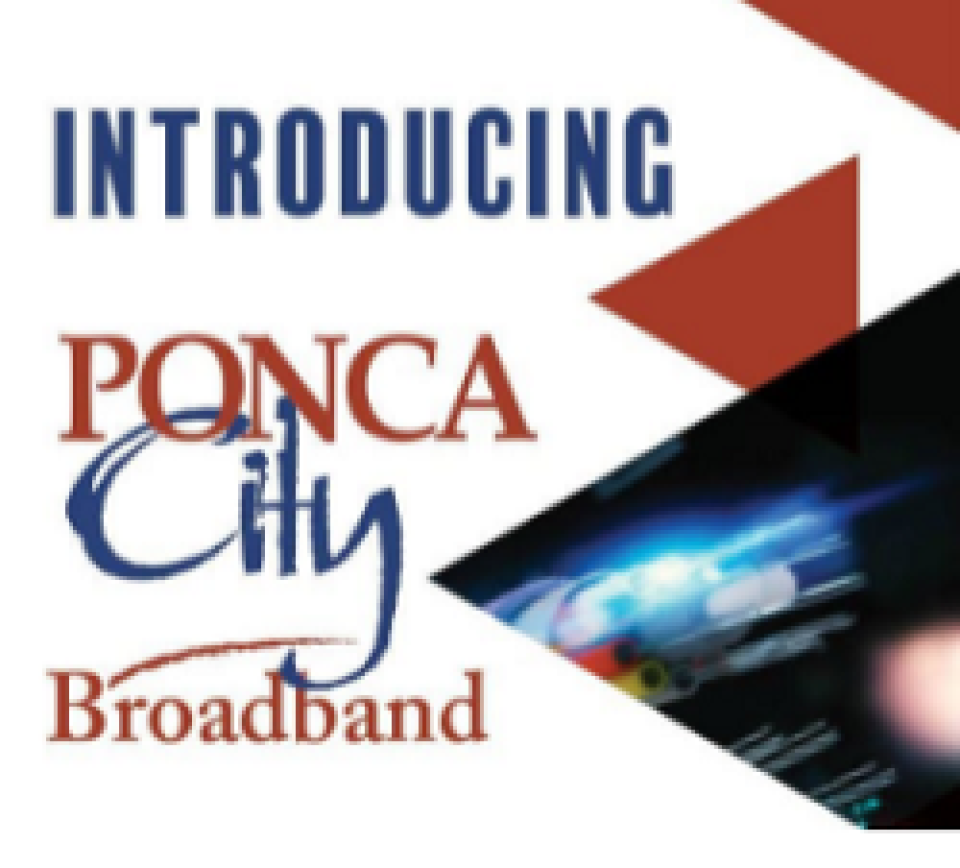
Fast, affordable Internet access for all.

Ponca City, Oklahoma (pop. 24,100) sits in the north-central part of the Sooner State 100 miles north of Oklahoma City. Its history as a community built and shaped by the oil town looms large, from the E.W. Marland Mansion which still stands as a testament to the efforts of the oil baron who helped build the city in the first decades of the 1900s, to the Conoco Museum which offers residents and tourists a look at the history of the corporate giant which emerged in the latter half of the twentieth century.
But today, instead of pumping petroleum in the name of keeping the local economy strong, officials are broadcasting bytes to residents, business, government facilities, and community anchor institutions via their new municipal fiber utility: Ponca City Broadband. The project, which left its pilot phase two years ago in July, has passed the halfway point of a full greenfield overbuild which will see more than 400 miles of new fiber pulled to build the citywide network as it aims for completion in late 2022.
A Wired Upgrade

Ponca City’s current fiber-to-the-home (FTTH) project was born in 2014, when local officials began talking about bringing more robust connectivity to every location in town. While it began laying fiber for city services as far back as 1996 and used those assets as the basis for a free citywide public Wi-Fi network which launched in 2007, the onset of increased usage that went with HD streaming services called for more. The solution they landed on was a fiber-to-the-home network hitting every premises in town, with planning beginning around 2015. When we last checked in with Director of Technology Services David Williams in July of 2019, the network was completing Phase 1: a 1.5-square-mile rectangular area sitting squarely in the center of town.
Today, Ponca City Broadband is nearing the end of Phases 2 and 3, constituting about half the total geography of the municipality. 500 users subscribe to the network today, with service areas of about fifteen square blocks going up as quickly as local leaders can manage. The network’s in-house crews are able to do about 15 installations per week, Williams shared in a recent interview, and the network has been periodically utilizing the services of a local electrician who can do an additional 20 or so. As the service area begins to expand, Williams said, they have the option of bringing in an Oklahoma City-based firm that can do as many as 400 per week, though they have not used them as of yet.
At the beginning of July, six service areas were complete for the Phases 2 and 3 builds, with another 10 in the final certification process scheduled to go live by the end of the month. At that point, the network will pass 65 percent of locations in town.
Phase 1 passed about 2,000 homes, but interest continues to build quickly. In the last six months the network has signed up 50 percent of all of its users. Original plans called for a 35 percent take rate as they ramped up construction and marketing efforts, and today they are well on their way at 25 percent. The network’s success is further marked by its continued strong business subscriber base, which began signing up users in 2005 on its original fiber. Despite not putting resources to advertising, the network’s business users has grown steadily to over 100 accounts and continues to see strong demand, with network plans to transition those users to the new system as soon as they are able.
Finishing the Network
Ponca City Broadband is also in the final engineering stage for Phases 4 and 5, which will go out for bid in October, see a contract awarded in November, and construction begin in December. City officials anticipate an approximately 54-week buildout for the final part of the network and an anticipated completion date of December 2022. If network planners hit those benchmarks it would put the project about a year and a half ahead of the original schedule and on budget.
The entire network was projected cost $20.4 million, though like others around the country construction efforts have faced material- and labor-cost increases (and material shortages) during the current supply chain shortages. Williams shared that fiber for Phase 1 had a delivery time of 6 weeks; for Phases 2 and 3, it has been six months. The network ordered its fiber for Phases 4 and 5 back in March 2021 in the hopes it would begin arriving in December.
Once complete, the Gigabit Passive Optical (GPON) network will be comprised of between 350 and 420 miles of new fiber. At that point, the network will move the legacy system off of its old network and decommission that infrastructure. While an original design called for using that original network (some parts of which were 20 years old when new work begun) as the basis or part of the new broadband system, they discovered in early planning that a brand-new build would cost just $100,000 (4.2 percent) more while providing a professionally engineered and constructed system. By doing that, it would allow them to avoid significant time and money mapping routes and splice points for the new FTTH network.

The city’s old system was constructed piecemeal over time, and thus came to be characterized by significant distribution fiber but lacking a unifying high-level design and robust transport loop. The new Ponca City Broadband is supported by a 5 GB backhaul circuit via two separate providers for redundancy. And, even with increased usage during the pandemic and more users being brought online every day, the network has only seen burst usage of slightly more than 1 GB, Williams added. Either provider, he has shared, is enough to handle the entire network load at present, providing redundancy at a cost of just $1,700/month.
Funding for the network has come from a variety of places. Phase 1 was paid for with cash reserves from the utility authority. Phases 2 and 3 have been funded via a loan backed by additional cash reserves, for which the new network will make regular debt reduction payments once complete. Phases 4 and 5 were originally planned to be funded by a revenue bond issue backed by future revenue, but falling interest rates in the late part of 2020 led the city instead to take advantage of a 10-year commercial bank loan with an interest rate of less than 2 percent at a time when the average bond index was a little over 2.25 percent. Local officials anticipate no trouble retiring this remaining debt, though they would have the opportunity to refinance should they choose.
Lessons Learned
Part of the citywide network’s success came in combining its bid processes for Phases 2 and 3 and Phases 4 and 5, Williams said. Another is in coordinating with the city’s electric utility, Ponca City Energy, which has been moving more and more of its electric infrastructure underground in recent years. Whenever the electric utility moves to a new area, it pulls a two-inch conduit capped at both ends for the broadband network to use when it reaches that part of town. Finally, Williams pointed to good customer service and value as the reason they have been able to keep the churn rate low: less than 10 percent since going live more than two years ago. He has also attributed success to a three-prong philosophy regarding the network:
It is locally owned and operated – so the business decisions are not only be made here, the revenues stay here as well,
It is comprised of 100% fiber optic cabling; nothing else, anywhere in the network - which none of the competition can honestly lay claim to, and
It is being backed by the good reputation of the Ponca City Utility Authority – so there’s built-in trust
Ponca City Broadband will add to the city’s utility portfolio, joining the other four services of electric, water, wastewater, and solid waste. Word of mouth has been driving signups as the network moves from one service area to the next, though yard signs have also helped spread the word. Meanwhile, the department still operates its original free public Wi-Fi network, called Ponca City Wi-Fi, which connects “an average of 17,000 unique devices to the Internet, every day.”
Beyond that, city officials are looking forward to the new fiber network help the city to enhance its smart city initiatives, which began almost 15 years ago with meter reading. It also includes traffic lights and school speed zone controllers, but the city isn’t necessarily stopping there; they are installing an additional 30 percent of fiber for future projects down the road.
What the Future Holds
Besides bringing FTTH service to city residents, the Ponca City network will be well-positioned to expand beyond the city limits, bringing fiber connectivity to surrounding communities in the years to come. Two miles outside city limits are 8,000 additional households where most, Williams said, are stuck on connections slower than 25/3 Mbps (with anecdotal reports of real-world download speeds of just 3-10 Mbps). While the primary agenda is to finish the build across the city as quickly as possible, the network has tentative plans to expand until it becomes economically infeasible, driven by strong demand from residents stuck on those connections.
Current Ponca City Broadband subscribers can choose between three tiers of symmetrical service with no data caps: 50 Mbps (Megabits per second) for $60/month, 100 Mbps for $100/month, or 1 Gbps for $250/month. It does not offer voice or video services at this time. The vast majority opt for the 50 Mbps service, Williams shared. Activation costs $200 but can be paid for up front or over two years. Users also have the option to lease mesh network extenders, which the network prefers over troubleshooting range, speed, and latency issues that come with using third-party solutions.
For more on the history and development of Ponca City Broadband, listen to David talk with Christopher on the Community Broadband Bits podcast below.
Header image by Wikimedia user Reservoirhill CCY by 2.0
